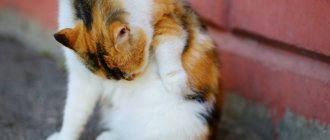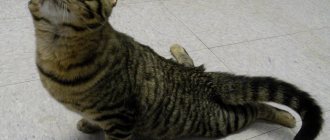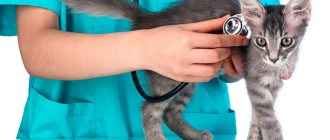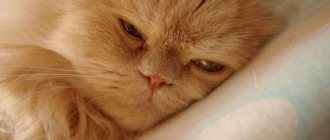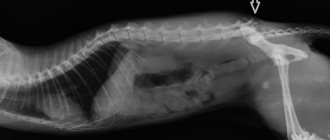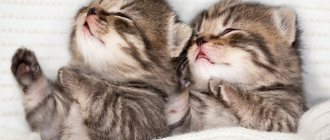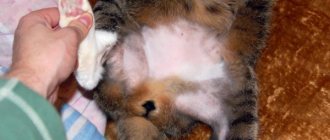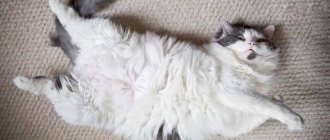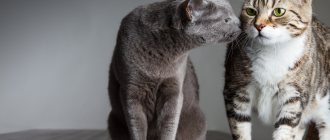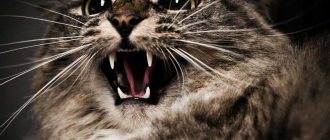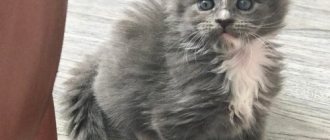One area of the body is going bald
Baldness in the area of the hind legs most often occurs with liver lesions.
If only one area is balding and there are no visible reasons for this, you should urgently consult a doctor for a full comprehensive examination.
Avitaminosis
For normal functioning, the cat's body requires a complex of vitamins.
For normal functioning, the cat’s body, like the human body, requires the entire complex of vitamins and minerals, and the lack of them provokes various pathological processes. A lack of vitamins of a certain group is manifested by specific symptoms characteristic of this particular pathology.
Alopecia
A lack of B vitamins in the body can cause periodic vomiting in a cat.
- Along with the main symptom, there is a disorder of the digestive system in the form of periodic vomiting.
- Signs of dysfunction of the nervous and muscular systems appear.
- The animal is weak, lethargic, has an unsteady gait, and a sharp loss of weight.
- Global deficiency of vitamin B1 is expressed by paralysis and convulsions.
- Eliminated by eating more raw meat, bone meal, and yeast.
- Among other things, replenishment is required through the use of special vitamin preparations.
- Deficiency of vitamins B2 and B5 is manifested by cracks in the mucous membranes, slower growth of babies, decreased heart rate and body temperature.
- Eliminated by consuming dairy products and foods of plant origin.
- A lack of vitamin B12 manifests itself in more serious complications such as constipation, urination problems, enlarged liver and spleen, and intestinal colic.
Help only under the supervision of a veterinarian.
Cirrhosis of the liver
Liver cirrhosis in a cat.
As a result, a malfunction occurs, and subsequently a complete failure of all functions of the organ. There are several reasons for the appearance of this pathology.
Primary factors
Primary factors are most often caused by gradual intoxication of the body and, as a result, a large accumulation of toxins in the liver.
Another reason that led to cirrhosis is hypovitaminosis of group B. With this pathology, symptoms appear after some time, as a result of the action of some aggressive factor.
Provoking factors are also the failure of metabolic processes and hereditary predisposition.
Lack of food containing B vitamins can lead to cirrhosis of the liver.
Secondary factors
Infectious or invasive diseases and pathologies of the cardiovascular system act as secondary aggressors.
Infectious diseases can cause cirrhosis.
Signs
- For a long time, the only sign of cirrhosis may be baldness of the pet in the abdomen and hind legs .
- Further, as the disease progresses, the abdomen becomes enlarged , which may indicate ascites.
- The cat looks tired, shows apathy and aggressive reactions to any attempts at contact.
- Decreased appetite, weight loss, and severe thirst.
- Frequent urination.
- In the final stages, convulsions , loss of coordination, and decreased vision .
An enlarged abdomen may indicate ascites.
Treatment and therapy
Treatment is aimed at maintaining the heart and stopping the progression of the disease. If you refuse to eat, force-feeding is used using a drip infusion of glucose solution. Vitamin therapy and diuretics are prescribed.
If you refuse to eat, feeding with a drip solution is used.
Endocrine focal symmetric alopecia
Like most pathologies, it cannot arise independently and there are quite a lot of provoking factors: hypothyroidism, hyperfunction of the thyroid gland, hyperfunction of the adrenal cortex, diabetes. As a rule, symmetrical baldness is not accompanied by itching , although in the presence of allergic reactions a similar phenomenon is quite possible, but in very rare cases.
As a rule, baldness is not accompanied by itching.
Treatment
Treatment depends on the identified pathology and is applied strictly under the supervision of a veterinarian. The owner’s only comprehensive help is timely contact with a specialist.
Source: https://mykoshka.ru/pochemu-u-koshki-lyseet-zhivot-i-zadnie-lapy-chto-delat/
Establishing diagnosis
Algorithm for making a diagnosis by a veterinarian:
- collecting anamnesis (information about previous diseases, introducing new foods to the diet, recent moves, etc.);
- inspection;
- general blood analysis;
- hair microscopy;
- scraping the skin to identify fungal infections;
- Ultrasound and x-ray as needed.
It is possible to accurately determine the root cause only by excluding already known points. For example, if there are no bites or changes in feeding, an allergy can be ruled out. An examination of the animal is mandatory, during which it is necessary to carefully examine the belly and paws. It is equally important to establish the condition of the hairs themselves and evaluate the affected area. Bare spots can be either extensive or very small. If your cat has recently undergone surgery, the hairs at the site of the suture may thin out or stop growing altogether. It often happens that they fall out at the injection sites of medications.
Belly hair loss in cats
Belly hair loss in cats can occur quite suddenly. But this symptom is not only unpleasant, but also indicates serious health problems. Having noticed bald spots on their pet's belly, owners sound the alarm. What can cause a cat's belly to become bald?
Determining the cause of baldness
Unfortunately, it is not so easy to understand the cause of abdominal hair loss in a cat. As a rule, only by sequentially eliminating all possible causes can one find out the true one. Therefore, you should not neglect a visit to the doctor. It is better to understand the origin of alopecia, which is the scientific name for baldness, with a professional.
Alopecia, or feline baldness: what is it?
How to remove fur from a cat's stomach at home
This is complete or almost complete baldness in certain areas of the skin with the formation of crusts and the appearance of itching. The skin peels, turns red, and the animal constantly tries to lick this area.
Alopecia in cats can occur as a result of:
- changes in hormonal levels;
- the appearance of fungus;
- mechanical damage;
- stressful situation;
- vitamin A deficiency;
- obesity;
- allergies, food intolerance to certain products.
Only a doctor can determine the cause and prescribe treatment. It is impossible to determine on your own at home why a kitten is going bald and the reason.
Alopecia in cats: table of symptoms and treatment methods
The beautiful, soft and silky coat of our pets is a clear sign of their good health. Loss of hair, therefore, may indicate some serious pathologies in the animal’s body. One of the most complex disorders in cats is alopecia. It is divided into two types:
- Symptomatic , when the pathology is only a visible effect of another cat disease.
- Idiopathic . It occurs “on its own”; more often it is impossible to identify visible causes.
In addition, the pathology can be focal, when hair falls out only in a limited area, and generalized (mass baldness over a large area). In addition, symmetrical alopecia occurs in cats, in which hair falls out symmetrically on all sides (hormones, chemotherapy) and asymmetrically, when hair loss is observed in only one area of the body.
What it is?
The term “alopecia” in this case refers to hair loss, and it can be either local or massive, systemic. Simply put, this is baldness.
In cats, this “disease” is quite common, and the causes of this disorder cannot be identified in all cases... However, such a pathology as psychogenic alopecia in cats has already been fully studied and confirmed.
It occurs in the most “finely organized” animals.
Most often, chronic or very severe stress (even short-term) leads to this outcome. Cats are very sensitive animals to changes in their environment, so many things can cause it. Hair loss often begins suddenly, and within a couple of days your pet becomes a “Sphynx”, regardless of its original breed.
Here are the main reasons for what is happening:
- The appearance of a new cat in the house.
- Moving to another house or city.
- Large-scale renovation.
- The birth of a child, to whom all the attention of the cat’s owners is now directed.
- Death or divorce.
- “Chronic” chaos in the apartment.
- Boredom and a depressed, apathetic state.
- Restriction in movement (after injury, when a cast is applied).
- "Toilet problems."
What to do with a “mentally unstable” cat?
- Carefully evaluate your pet's living conditions, paying attention to the slightest changes that could cause baldness.
- Even a new diet or litter tray are “good” causes of alopecia in cats.
- If your work schedule has changed, as a result of which your cat spends days and nights in splendid isolation, sitting in the apartment, then you should not be surprised at the massive hair loss.
- There is no need to immediately start feeding your pet sedatives. It may be possible to find an alternative solution. So, if the changes in the cat’s environment are not so critical and “monumental” (a new litter box, for example), you just need to be patient: soon everything will return to normal, and your pet’s fur will grow back.
- But what if you simply have to rarely be at home? Then, no matter how strange it may seem, it’s worth getting a second cat.
- Yes, this is a very unique “treatment” at home: at first there will be fights and quarrels, which are also a strong stress factor, but at least the cat will not be alone all the time.
- If your pet is okay with dogs, we recommend getting a puppy. A cat (especially a young one) will have a playmate. Pets in such conditions quickly become best friends.
Symptoms
A healthy cat's fur is smooth, shiny, firmly held in the skin, and the coat itself is not ruffled.
With the development of alopecia, areas of baldness can be complete or partial, located symmetrically or not. In some cases, the animal may scratch these areas, and the skin here may be hot and red.
Rice. 2. Partial alopecia on the back of a cat.
In skin diseases or behavioral disorders, alopecia is symmetrical on the trunk, forelimbs, thighs, sides or abdomen. The age and gender of the animal do not matter.
When stress occurs, hairs broken and torn out by the cat itself are found in the back, on the limbs, stomach and inner thighs, near the genitals and anus. Cats of “nervous” breeds are especially susceptible: Siamese, Burmesse, Himalayan and Abyssinian. These breeds will have darker hair color after restoration.
In case of hormonal imbalances, alopecia is observed in the area of the bridge of the nose, croup, base of the tail, hips, and chest. The skin loses its elasticity.
And if there is a lack of thyroid hormones in a cat, hair in the area of the pelvic bones is easily pulled out by the roots. Such alopecia, including asymmetrical ones, are recorded on the abdomen, chest and neck. The cover is restored with difficulty.
With malignant tumors, there is a complete absence of hair shafts on the abdomen, alopecia quickly spreads to the chest and limbs, and then can affect the entire surface of the skin. At the same time, the skin on the affected areas shines.
With vitamin deficiency A, alopecia areata develops: spots without hair, round in shape, form on the skin, which merge to form large alopecias. The skin has a bright pink color.
With microscopic fungi (trichopytosis, microsporia), hairless areas of the skin are reddened and may have scales and crusts, scabs and wounds.
With scabies, redness, itching, and in particularly advanced cases, purulent inflammation of the skin are observed. Dermatitis is accompanied by an increase in local body temperature, scratching, the appearance of pimples, etc.
If the course of alopecia is unfavorable, an infection may occur, and then an inflammatory process develops on the skin.
Causes, signs and treatment of baldness in cats
Cats regularly lose some of their fur hairs, especially a lot of hairs fall out when shedding, but these are not signs of baldness in cats, this is a completely natural process associated with the renewal of the hair coat to increase the comfort of the animal and is associated, most often, with the change of seasons.
Alopecia in cats refers to the process of abnormal hair loss, which results in severe thinning (and in some cases complete absence) of hairs in a certain area of the body.
Baldness should immediately alert the pet owner, since it is a sign of a disturbance in the animal’s vital processes and serves as a sign of a serious illness in the pet.
At the slightest sign of baldness, you should immediately contact a veterinarian.
Causes of baldness in cats
First of all, baldness in cats should be divided into two types: congenital and acquired baldness. Experts do not have a common point of view regarding congenital baldness. However, most experts are inclined to believe that this anomaly is associated with a lack of certain vitamins, nutrients, or endocrine disorders in the fetus.
The version of the influence of inbreeding is also not rejected. Natural baldness is typical for cat breeds such as bambino, sphinx, elf, and cojona. In this case, alopecia is not a pathology, but rather a characteristic of the breed.
With acquired baldness in cats, the issue has been studied more thoroughly and today several causes of the disease in animals have been identified. Alopecia of a symptomatic nature includes baldness caused by scabies, ringworm, dermatitis of various origins, seborrhea or metabolic disorders.
Alopecia of an idiopathic nature is explained by infectious diseases, the influence of toxins, and radiological exposure. The so-called alopecia areata in cats is a little different.
This disease manifests itself in the form of small round spots devoid of fur. In some cases, adjacent spots may merge into a large area of baldness. Due to the lack of hair, the animal’s skin is clearly visible; in light-colored cats, this skin is pink.
Veterinarians explain the appearance of this type of baldness by a lack of vitamin A, which is necessary for normal blood circulation in cats, which supplies the hair follicles with nutrients. In the initial stages, this form of alopecia resembles molting, but the distinguishing feature is the fact that the hair in the area devoid of hair does not grow back at all.
In some cases, veterinarians record cases of animal baldness due to the use of low-quality bathing shampoos, as well as excessively frequent bathing of the pet.
How to treat baldness
How to treat alopecia largely depends on the diagnosis. Many mustachioed owners, when they see a bald area, scream in horror - “deprivation!” and begin to look for something to anoint. The approach is completely wrong.
For feline alopecia, complex treatment is most often prescribed. Local therapy is indicated if there is a bacterial or fungal infection.
The algorithm is as follows:
- Treatment of the underlying disease that causes hair loss in cats.
- If skin parasites are identified, drops, tablets, and shampoos are prescribed to get rid of them. The prognosis is good if antiparasitic treatments are carried out regularly.
- For infections, a course of antibiotics.
- In case of an allergic reaction, the allergen is eliminated. If your cat has a food allergy, review the diet and eliminate it. The prognosis is good if the food is chosen correctly. If the allergen is not identified, the prognosis for recovery is cautious.
- If it's stress, the cause should be ruled out. With proper behavior correction, the prognosis is satisfactory. The therapy is long-term and requires patience from the owner.
- If tumors occur, surgical intervention is required. Timely surgery gives the right to make a positive prognosis. In advanced cases, the animal is not operated on.
Regardless of the reason, it is additionally necessary to strengthen the animal’s immunity. Sometimes the question arises about selecting a diet in accordance with age, state of health, and physiology.
Cat licks fur until bald spots treatment
Licking fur is a normal state for a cat. But everything should happen in moderation. If your pet is licking its fur excessively to the point of baldness, you need to think about it. Most often this is a sign of some kind of problem. Let's look at the most common of them.
Stress
Unusual and even inappropriate behavior of a cat is not always a consequence of deteriorating physical health of the animal. Sometimes the reason has an emotional basis.
A number of situations can cause stress in a pet:
- relocation of one of the family members;
- rearrangement of furniture;
- loss of a pet's favorite toy;
- the appearance of another animal in the house and much more.
A cat's life is predictable and orderly, and anything that brings change is not always good for the pet.
Owners often try to impose rules on the cat.
Licking causing increased skin balding is abnormal
But a freedom-loving animal may have its own thoughts on this matter. It is impossible to act impudently here, and you will achieve nothing. It can cause emotional stress. It is better to find contact with the pet, some kind of mutual solution.
Compromise is the only true way out of the situation.
If your pet feels itchy, it begins to actively lick these places. Moreover, there is a pattern: a cat licks wounds more accurately than itches. If the licking area is large, it means the cat is itching there. Moreover, attentive owners have noticed that when itching, animals most often lick their back, stomach and other parts of the body.
Parasites
If an animal is bothered by parasites, it most often licks its tail. Upon external examination, you can notice a problem in the form of small bites and fleas, ticks and other pests. It is recommended to immediately contact a veterinarian for treatment. Because for a pet this is a real punishment.
Allergy
Cats are more likely to have food allergies. For example, for dry food, which the animal cannot eat in nature, or for its individual components. Sometimes, of course, medications cause side effects. But this happens less often. You can try changing your diet. You need to consult a specialist; you may need to take antihistamines.
Damage to the skin
Animals have no other way to restore health than to do it themselves. And licking wounds is proof of this. The pet instinctively tries to help itself. But if you have already applied the ointment, it is better to exclude this possibility. Apply a bandage or otherwise limit the animal’s access to the wound site. You can wear a special collar.
A cat can lick itself to such an extent that there is no fur left on the skin.
Cats by nature do not like closed doors. They will constantly be tormented by the question of what is happening in the closed area. Imagine that a person was imprisoned in an apartment and forbidden to leave. Over time, he will begin to tear out his hair. Especially if you previously liked to walk outside for a long time. And animals are no exception.
Although a cat can make do with a small space to exist, too little space is also bad. It is recommended to consider the interests of the pet. This is a living creature that also has its own needs.
In the process of licking, the cat can harm itself.
The ones who suffer the most are:
- front legs;
- front or back of the body;
- the abdomen, where wounds most often appear;
- the inside of the hind legs.
With both physiological and mental causes of licking problems, solving them requires time and patience.
If the animal is healthy, then there is no danger for humans in licking it. Moreover, animal psychologists do not advise rejecting your pet at this moment, even if it is unpleasant for you.
Licking serves as a basic means of communication
It is recommended to somehow gently show the pet that this should not be done in the future.
Some even believe that cats sense their owner’s sore spots and heal them with their energy by licking him.
The behavior of pets can be studied over a long period of time. Some lick themselves right down to their bald patches, causing damage to their health. Others may lick people to show their feelings.
We need to fight it. Whereas such a procedure will not bring danger to humans. This is provided that the pet is absolutely healthy.
Licking serves as a basic means of communication
In any case, it is worth understanding that licking itself is a problem.
But sometimes excessive hygiene can lead to the formation of wounds, scratches, bald patches and rashes. This is a clear sign that the cat has health problems. There are many reasons for this compulsive licking.
The main thing is to notice them in time and diagnose the pathology.
The owner must control the behavior and condition of the animal. Excessive licking develops into a habit that persists even after the cause of this phenomenon is eliminated. With timely treatment of the disease, this habit goes away on its own in about 20 days.
Overgrooming is a fairly serious deviation that can lead to negative consequences. Lack of timely and correct assistance can lead to:
- The formation of wool plugs in the stomach and intestines of cats, leading to their obstruction and accumulation of feces.
- The appearance of non-healing wounds, ulcers, scratches, which are open gates for various types of infections. In severe cases, this can lead to the formation of necrotic lesions. To prevent such situations, you need to treat wounds with antiseptic sprays and ointments, cover them with bandages and plasters.
- Disturbances in the natural growth of the coat, as well as deterioration of its protective functions.
We invite you to read: The danger of obesity in cats - WorldKoshek.Rf || How to tell if my cat is too fat
Overgrooming is a pathology that requires a special approach, as well as great responsibility. If its cause was physiological health problems, then treatment should be aimed at eliminating them. After recovery from the underlying disease, pathological licking will go away on its own.
Overgrooming is excessive licking of an animal, which leads to the formation of areas with broken or sparse hair. Sometimes real bald patches appear, where the villi are completely absent.
After an external examination and, if necessary, laboratory tests, it is important to identify the true reason why he is ready to lick. And from this we consider the direction of therapeutic treatment.
If the essence of the problem is stress, it is important to exclude such situations. You may even need to contact an animal psychologist.
Since fleas and ticks can also cause active licking, if you notice them, you need to treat your pet for parasites.
In any case, you cannot do without qualified help. Only care on the part of the owner and the professionalism of the veterinarian will allow the animal to be cured and returned to its former life.
The further you go, the more difficult it is to deal with the problem.
To prescribe effective treatment, it is recommended to consult a veterinarian.
You should not delay treatment so that your pet does not get into the habit of actively licking itself.
Overgrooming is excessive licking of fur. Signs of this disease are the formation of patches of fur with broken or sparse hair on the animal’s body.
Overgrooming is directly related to stressful situations that pets have experienced.
Are you faced with the fact that your cat licks its fur down to its skin and you don’t know how to treat it? First, you need to establish the exact cause of the abnormal behavior that appears, because this is what further actions will depend on. In some cases, long-term and painstaking treatment will be required, and in others, improvement of living conditions. An experienced veterinarian will help you deal with the problem.
Animals express emotions and feelings in their own way. Often, feeling affection, they lick people and can lick gently. Although there may be other reasons for what is happening. Let's look at them in detail.
Many cats consider licking their owners a mandatory ritual.
When expressing their affection, cats rarely lick a person. This is most often the prerogative of dogs. But sometimes they can lick the owner's face or hand. And this will be a short-lived act.
To express tender feelings towards a person, cats use other methods:
- they purr gently;
- They cuddle up to their owner's hands so that he can stroke them.
During the period of motherhood, it is typical for cats to care for and show tender feelings towards their offspring.
When a female reaches puberty and her body becomes ready for reproduction, hormonal imbalance may occur.
If this is attachment to the owner, then he will become the object of her courtship and care. There is a false manifestation of parental instincts.
Begging
If a pet licks a person's hands, especially the palms, this is an indication of begging. Practice shows that a kitten that was raised by artificial feeding will definitely lick the back of the owner’s hand if it wants a tasty snack.
If your pet is not given enough attention, it may lick itself out of boredom. Most cats, of course, resort to gluttony. But active licking also occupies a special place in this rating.
If the problem is not corrected in time, the pet will cause significant damage to its health. Because the wounds will not have time to heal.
And from the point of view of the physical state of health, this will be regarded as a pathology.
Strong smell
In nature, pungent odor is a significant problem for animals. Because predators have a greater chance of catching such a smelly fish. If a person came after a run or just from work, and the cat began to actively lick him. This indicates that he does not smell very good.
Treatment
As a rule, an accurate diagnosis for balding cats is made by a veterinarian. He also prescribes the necessary treatment. It is usually aimed at treating hair loss and combating the underlying disease. Therefore, there are several different ways to restore hair:
- If a cat becomes very bald on its belly due to poor nutrition, a special diet is prescribed for it.
- If alopecia is associated with allergies, then the first step is to exclude contact with the allergen, after which the animal is prescribed medications to strengthen the body’s immune system.
- Alopecia caused by skin diseases is treated with a course of antibiotics. The most common use is amoxicillin, but you should consult your doctor before using the drug.
- When abdominal hair loss is associated with stress, the animal is prescribed sedatives.
- In the case when a bald spot on the stomach is formed due to blood-sucking parasites, the cat must be treated with special substances, and immunostimulants and vitamins must be added to its diet.
- For demodicosis, it is recommended to give the animal regular baths with the addition of one percent sulfur-selenium shampoo.
The most unpleasant treatment for both the cat and the owner will be if ringworm is detected. In this case, you will have to shave your pet’s hair and give him the following medications:
- Ketoconazole;
- Itraconazole;
- Griseofulfin.
For better absorption of the latter drug, it is recommended to give it along with a small piece of butter.
Each individual case is treated individually. Before starting treatment, you must consult a specialist. And in order to prevent alopecia, you can carry out special prophylaxis for the animal.
Description of the problem
A cat's fur can thin out both for physiological reasons and under the influence of pathological factors. In cases of pathological hair loss, bald patches are formed, that is, areas in which new hair does not grow.
The lack of fur in some area in itself is not a problem. However, this symptom may indicate the development of a disease that negatively affects the pet's health. Therefore, if a cat is peeling, you shouldn’t ignore it; you definitely need to figure out the cause and carry out appropriate treatment.
